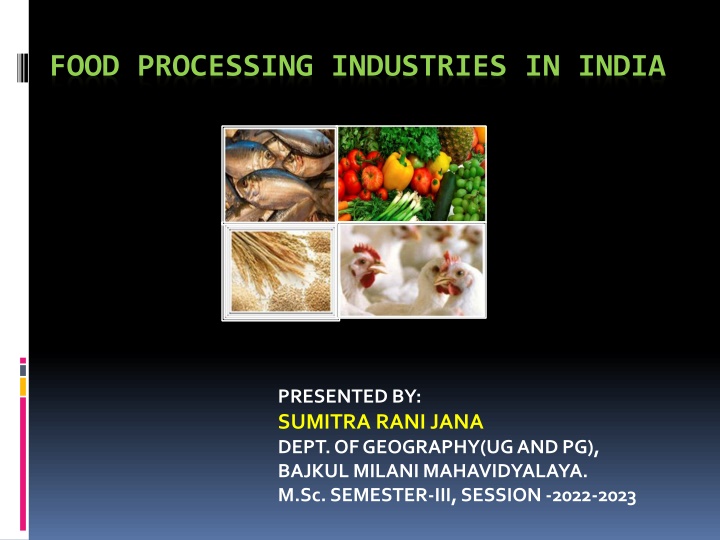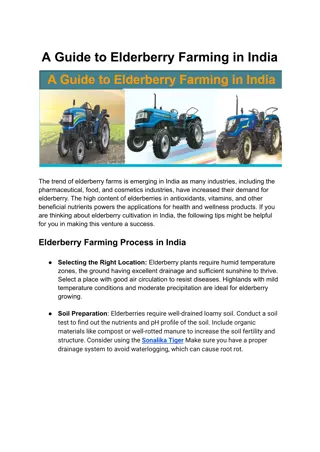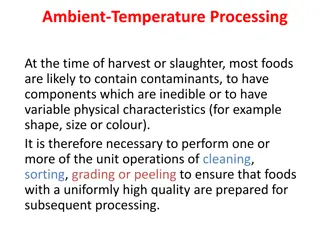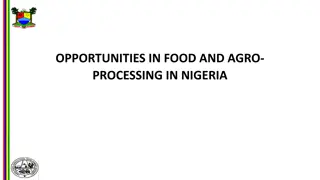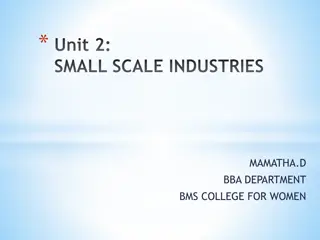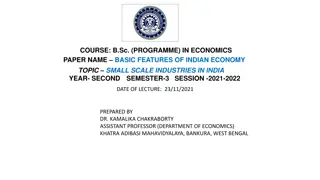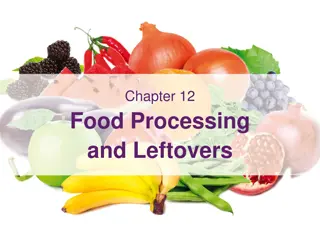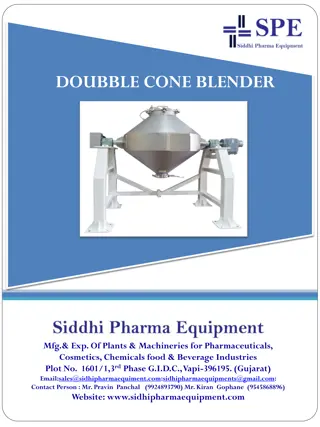Food Processing Industries in India: Overview and Opportunities
The Indian food industry is experiencing significant growth, positioning itself as a major player globally. With diverse segments like fruits, vegetables, milk products, meat, and seafood, India holds immense potential in food processing. Significant contributions in fruit and vegetable production, milk, and livestock indicate the country's promising future in the food processing sector.
Download Presentation

Please find below an Image/Link to download the presentation.
The content on the website is provided AS IS for your information and personal use only. It may not be sold, licensed, or shared on other websites without obtaining consent from the author.If you encounter any issues during the download, it is possible that the publisher has removed the file from their server.
You are allowed to download the files provided on this website for personal or commercial use, subject to the condition that they are used lawfully. All files are the property of their respective owners.
The content on the website is provided AS IS for your information and personal use only. It may not be sold, licensed, or shared on other websites without obtaining consent from the author.
E N D
Presentation Transcript
FOOD PROCESSING INDUSTRIES IN INDIA PRESENTED BY: SUMITRA RANI JANA DEPT. OF GEOGRAPHY(UG AND PG), BAJKUL MILANI MAHAVIDYALAYA. M.Sc. SEMESTER-III, SESSION -2022-2023
INTRODUCTION: The Indian food industry has witnessed strong growth over the past few years. India is the world s second largest producer of food next to china, and has the potential of becoming the biggest producer in the years of come. Food processing- one of the world s largest industries from the perspective -number of companies involved in the sector, -Total economic value.
CLASSIFICATION OF FOOD The food processing sector comprises six major segments: i. Fruits and vegetables ii. Milk and milk products iii. Meat and poultry iv. Fisheries and Sea food v. Grain processing vi. Alcoholic Beverages
FRUITS AND VEGETABLES Second largest producer of the fruits(81.285 million tones) and vegetables(162.19 million tones) in the world(2013-2014) Contributing to the world production -Fruits-12.6% -Vegetables-14.0% Banana, mango, citrus, papaya, guava and grape account for major share in total fruit production. Potato, tomato, onion,brinjal, cabbage, cauliflower and tapioca account for maximum share in the vegetable production.
MILK AND MILK PRODUCTS India has the largest livestock population with milk cows and buffaloes being its main constituent. India is the world s largest milk producer (72 million tones annually) and the dairy industry has been recognized the world over as its most successful development programme going by FAO estimates, while world milk production fell by 2% in the last three years, the Indian production galloped by4%. While consumption of liquid milk accounts for 46% of the total production, the rest is converted into milk products.
MEAT AND POULTRY India has the world s largest livestock population, accounting for 50% of buffaloes and 1/6thof the goat population. FAO has estimated the existing production of meat and poultry products at 4.42 million tones. Only 11% of the buffalo population, 6% of cattle, 33% of sheep and 38% of the goat population is called for meat. At present, only a small percentage of the meat produced is converted into value added products and most meat is purchased by consumers in the fresh/frozen form for conversion into products at home, restaurants, etc. maximum conversion takes place in pork products.
FISHERIES AND SEA FOOD India boasts of the seventh largest marine landing base in the world with an extensive 7500km coastline and an exclusive Economic Zone of 2 million sq km, largely untapped, and a 2900km stretch of rivers and canals, 145 million hectares of reservoirs and 0.75 million hectares of tanks and ponds. Though Indi s fish potential from the EEZ has been estimated at 3.9 million tones, the harvest is only of 2.87 million tones. This can be increased to 3.37 million tones by intense tapping in offshore and deep-sea grounds using modern technology. There is also a good scope to improve fish harvest from inland waters which, at present is 2.7 million tones. Besides, the fish potential in aquaculture and shrimp farming has also largely remained untapped.
GRAIN PROCESSING The country s current food grain production(including rice, jowar, bajra, maize, ragi, wheat, barley, gram and pulses) has been put at 225 million tones a year. Grain processing, with a share of 40%, is the biggest component of the food sector. Its basic feature is pre-dominance of the primary processing sector, sharing 96% of the total value, with the secondary and tertiary sectors adding about 4%. Indian Basmati rice commands a premium in the international market.
ALCOHOLIC BEVERAGES Liquor made in India is categorized as beer, country liquor and Indian Made Foreign Liquor(IMFL). IMFL production comprises wine, vodka, whisky, gin, rum, brandy, etc. pre-mixed drinks like gin and lime, rum and cola are being introduced in India now. Draught beer is another recent introduction and has done well where introduced. Canned beer is also a recent introduced There are 36 breweries with a licensed capacity of 160 million liters per annum.
MAJOR CHALLENGES FOR THE INDIAN FOOD INDUSTRY: Inadequate infrastructure facilities Absence of comprehensive national level policy on food processing sector Food safety laws and inconsistency in state and central policies Lack of adequate trained manpower Lack of consumer education on nutritional facts of processed foods Lack of backward forward integration from farm to consumers.
SWOT of Indian food processing Industry Strength(S): Round the year availability of raw materials. Social acceptability of agro-processing as important area and support from the central government Vast network of manufacturing facilities all over the country Vast domestic market
Weaknesses(W): High requirement of working capital Low availability of new reliable and better accuracy instruments and equipments Inadequate automation with respect to information management Remuneration less attractive for talent in comparison to contemporary disciplines Inadequately developed linkages between research and development labs and industry
Opportunities(O): Large crop and material base in the country due to agro-ecological variability offers vast potential for agro-processing activities Integration of developments in contemporary technologies such as electronics, material science, computer science, bio-technology etc. offer vast scope for rapid improvement and progress Opening of global markets may lead to export of our developed technology to facilitate generation of additional income and employment opportunities.
Threats(T): Competition from global players Loss of trained manpower to other industries and other professions due to better working conditions prevailing there which may lead to further shortage of manpower.
